![]()
![]()
![]()
Use LEFT and RIGHT arrow keys to navigate between flashcards;
Use UP and DOWN arrow keys to flip the card;
H to show hint;
A reads text to speech;
23 Cards in this Set
- Front
- Back
|
Trapezius
|
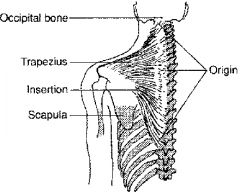
Origin: 1. Occipital bone 2. Vertebrae (cervical and thoracic)
Insertion: 1. Clavicle 2. Scapula (spine and coracoid) Function: 1. Raises or lowers shoulders and shrugs them. 2. Extends head when occiput acts as insertion Innervation: Spinal accessory, 2nd 3rd 4th cervical nerves |
|
|
Serratus anterior
|
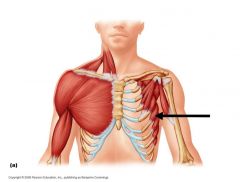
Origin: Ribs (Upper 8 or 9)
Insertion: Scapula (anterior surface, vertebral border) Function: Pulls shoulder forward, abducts and rotates it upward Innervation: Long thoracic nerve |
|
|
Pectoralis major
|
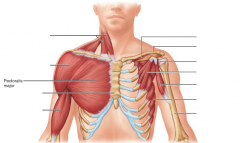
Origin: 1. Clavicle (medial half) 2. Sternum 3. Costal cartilages of true ribs
Insertion: Humerus Function: 1. Flexes upper arm 2. Adducts upper arm anteriorly; draws it across chest. Innervation: Medial and lateral anterior thoracic nerves |
|
|
Latissimmus dorsi
|
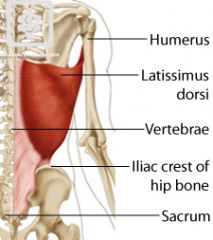
Origin: 1. Vertebrae (spines of lower thoracic, lumbar, and sacra) 2. Ilium (crest) 3. Lumbodorsal fascia
Insertion: Humerus (intertubercular groove) Function: 1. Extends upper arm 2. Adducts upper arm posteriorly Innervation: Thoracodorsal nerve |
|
|
Deltiod
|
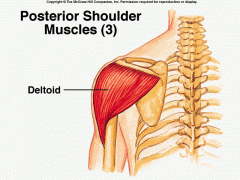
Origin: 1. Clavicle 2. Scapula (spine and acromion)
Insertion: Humerus (lateral side about half way down deltoid tubercle) Function: 1. Abducts upper arm 2. Assists in flexion and medial rotation of arm Innervation: Axillary nerve |
|
|
Biceps brachii
|
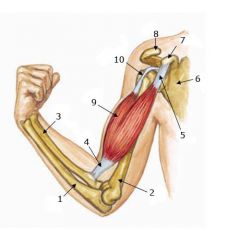
Origin: 1. Scapula (supraglenoid tuberosity) 2. Scapula (coracoid)
Insertion: Radius (tubercle at proximal end) Function: 1. Flexes supinated (turned so that palm or sole is facing up) forearm 2. Supinates forearm and hand Innervation: Musculotaneous nerve |
|
|
Brachialis
|
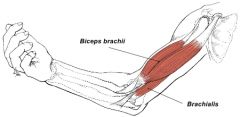
Origin: Humerus (distal half, anterior surface)
Insertion: Ulna (front of coranoid process) Function: Flexes pronated (turned so that it is facing downward or inward) forearm Innervation: Musculotaneous nerve |
|
|
Triceps brachii
|
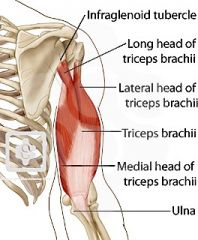
Origin: 1. Scapula (infraglenoid tuberosity) 2. Humerus (posterior surface-lateral head above radial groove; medial head, below)
Insertion: Ulna (olecranon process) Function: Extends lower arm Innervation: Radial nerve |
|
|
Rectus femoris
|
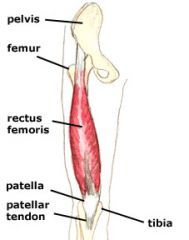
Origin: Ilium (anterior, inferior spine)
Insertion: Tibia (by way of patellar tendon) Function: 1. Flexes thigh 2. Extends lower leg Innervation: Femoral nerve |
|
|
Gluteus maximus
|
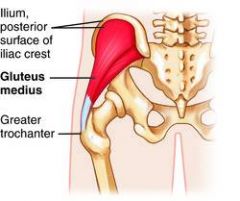
Origin: 1. Ilium (crest and posterior surface) 2. Sacrum and coccyx (posterior surface) 3. Sacrotuberous
Insertion: 1. Femur (gluteal tuberosity) 2. Iliotibial tract Function: Extends thigh-rotates outward Innervation: Inferior gluteal nerve |
|
|
Gluteus medius
|
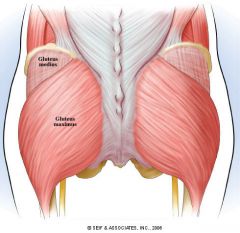
Origin: Ilium (lateral surface)
Insertion: Femur (greater trochanter) Function: Abducts thigh-rotates outward; stabilizes pelvis on femur Innervation: Superior gluteal nerve |
|
|
Vastus medialis
|

Origin: Femur
Insertion: Tibia (by way of patellar tendon) Function: Extends leg Innervation: Femoral nerve |
|
|
Biceps femoris
|
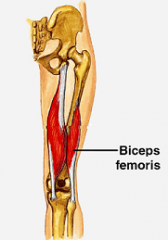
Origin: 1. Ischium (tuberosity) 2. Femur (linea aspera)
Insertion: 1. Fibula (head of) 2. Femur (lateral condyle) Function: Flexes leg Innervation: Hamstring nerve (branch of sciatic nerve) |
|
|
Semitendinosus
|
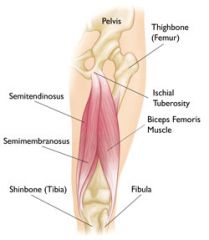
Origin: Ischium (tuberosity)
Insertion: Tibia (proximal end, medial surface) Function: Extends thigh Innervation: Hamstring nerve |
|
|
Semimembranosus
|
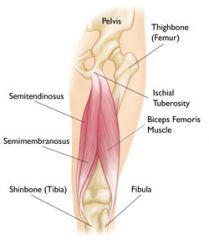
Origin: Ischium (tuberosity)
Insertion: Tibia (medial condyle) Function: Extends thigh Innervation: Hamstring nerve |
|
|
Gastrocnemius
|
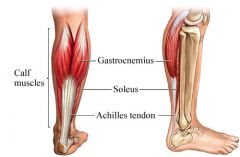
Origin: Femur (condyle)
Insertion: Tarsal (calcaneus by way of Achilles tendon) Function: Extends foot, flexes lower leg Innervation: Tibial nerve (branch of sciatic nerve) |
|
|
Soleus
|
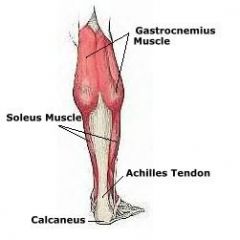
Origin: 1. Tibia (underneath gastrocnemius) 2. Fibula
Insertion: Tarsal (calcaneus by way of Achilles tendon) Function: Extends foot (plantar flexion) Innervation: Tibial nerve |
|
|
Sternocleidomastoid
|

Origin: 1. Sternum 2. Clavicle
Insertion: Temporal bone (mastoid process) Function: Flexes head (prayer muscle) One muscle alone, rotates head toward opposite side, spasm of this muscle alone or associated with trapezius called torticollis or wryneck |
|
|
External oblique
|
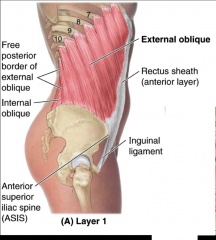
Origin: Ribs (lower 8)
Insertion: 1. Ossa coxae (iliac crest and pubis by way of inguinal ligament) 2. Linea alba by way of an aponeurosis Function: Compresses abdomen Innervation: Lower 7 intercostal nerves and iliohypogastric nerves |
|
|
Internal oblique
|

Origin: 1. Ossa coxae (iliac crest and inguinal ligament) 2. Lumbodorsal fascia
Insertion: 1. Ribs (lower 3) 2. Pubic bone 3. Linea alba Function: Compresses abdomen Innervation: Last 3 intercostal nerves, iliohypogastric and ilioguinal nerves |
|
|
Rectus abdominis
|
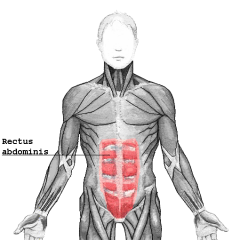
Origin: Ossa coxae (pubic bone and symphysis pubis)
Insertion: 1. Ribs (costal cartilage of 5th 6th and 7th ribs) 2. Sternum (xiphoid process) Function: Compresses abdomen, flexes trunk Innervation: Last 6 intercostal nerves |
|
|
Masseter
|
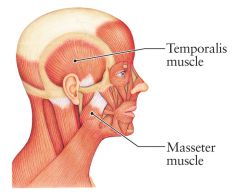
Origin: Zygomatic arch
Insertion: Mandible (external surface) Function: Closes jaw Innervation: Cranial nerve V |
|
|
Epicranius (occipitofrontalis)
|
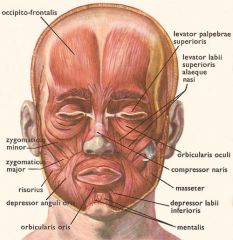
Origin: Occipital bone
Insertion: Tissues of eyebrows Function: Raises eyebrows, wrinkles forehead horizontally Innervation: Cranial nerve VII |

